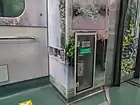LRTA 1200 class
The LRTA 1200 class is a class of high-floor LRV of the Light Rail Transit Authority (LRTA) in Manila, Philippines, which began operation in 2007.
| LRTA 1200 class Third-generation LRV | |
|---|---|
 LRT 3rd generation LRV | |
| In service | 2007–present |
| Manufacturer | Kinki Sharyo Nippon Sharyo |
| Built at | Japan (Osaka/Aichi) |
| Constructed | 2005–2006 |
| Entered service | 2007 |
| Number built | 48 vehicles[1] |
| Number in service | 44 vehicles |
| Formation | 3 or 4 cars per trainset (mono-articulated car body) |
| Fleet numbers | 1201–1248 |
| Capacity | 347 per car[1] |
| Operator(s) | Light Rail Transit Authority |
| Depot(s) | Baclaran |
| Line(s) served | LRT Line 1 |
| Specifications | |
| Car body construction | Stainless steel |
| Train length | 3-car trainset: 79,350 mm (260 ft 4 in) 4-car trainset: 105,750 mm (346 ft 11 in) |
| Car length | Motor end cars with driving cab: 26,500 mm (86 ft 11 in) Motor intermediate cars: 26,350 mm (86 ft 5 in)[2] |
| Width | 2,590 mm (8 ft 6 in) |
| Height | 3,430 mm (11 ft 3 in)[2] |
| Floor height | 920 mm (3 ft 0 in) |
| Doors | 4 per side, sliding pocket-type |
| Maximum speed | 80 km/h (50 mph) |
| Weight | Head cars: 37.4t Intermediate car: 36.5t |
| Traction system | Mitsubishi Electric IGBT-VVVF |
| Traction motors | Three-phase induction motor |
| Power output | 105 kW (141 hp) |
| Transmission | Two-stage reduction drive |
| Electric system(s) | 750 V DC overhead wire |
| Current collection method | Single-arm pantograph |
| Bogies | Inside frame type |
| Braking system(s) | Air and regenerative brakes |
| Safety system(s) | ATS, ATP |
| Track gauge | 1,435 mm (4 ft 8 1⁄2 in) |
History
In 2005, Sumitomo Corporation and Itochu Joint Venture Company Limited received an order of 48 Light Rail Vehicles (LRV) and signed a construction contract between Kinki Sharyo and Nippon Sharyo to supply 48 vehicles, the first train completed in December 2005.
The 3rd-generation trains started operations on December 9, 2006, with Japanese Prime Minister Shinzō Abe and former President Gloria Macapagal Arroyo attended the handover ceremony of 1200 series as part of the transportation capacity enhancement of the Manila LRT Line 1.
Design
Structure
The 1200 class' carbody is made of beadless lightweight stainless steel, with composite materials on the indoor panels and aluminum on the inner bone to reduce weight.
Each LRV is bi-articulated with inside-frame bogies which are 26 mm (1.0 in) in length. The carbody measures 26,000 mm (85 ft 4 in) in length, 2,590 mm (8 ft 6 in) in width, and 3,430 mm (11 ft 3 in) in height.
1200 class LRVs have 4 electronic sliding doors on both sides.
Interior
The interior is color-toned based on light and dark two-color green in the seats to complement the landscape of Manila. Seats are made of fiber reinforced plastic and has an aluminum bracket type cantilever longitudinal seat for reducing weight. Seating and grip sticks are designed to have ergonomic dimensions, aside from equipment arrangement inside the cab. A wheelchair-compatible space is provided beside the gangway of the intermediate car, alongside an equipped fire extinguisher.
_(Caloocan)(2017-07-08).jpg.webp) Interior of the 1200 class
Interior of the 1200 class Wheelchair strap and space, and fire extinguisher
Wheelchair strap and space, and fire extinguisher
Drive unit
The bogie is inside frame type with 600 mm diameter, the wheels are the same as the 1100 series, and the traction motors are Three-phase AC Induction motor producing 105 kW (141 hp)
The Traction control system is IGBT-VVVF that drives the four main motors of the two carriages. The resistors are mounted on the roof for backup regenerative brakes. The VVVF controller is manufactured by Mitsubishi Electric, and it has Electronic Command braking device supplied by Knorr-Bremse that uses air and regenerative brakes.
Operations
The 1200 class are operated with Automatic Train Protection and Automatic Train Stop and has disc brakes on the bogies.
Incidents
On February 18, 2011, two trains (1G and 3G) collided near Roosevelt Station in Quezon City at the reversing tracks, around a kilometer away to the east. No passengers were injured.
References
| Wikimedia Commons has media related to LRTA Class 1200. |
- "MANILA LRT1 EXTENSION, OPERATIONS AND MAINTENANCE PROJECT" (PDF). The Official Site Public-Private Partnership center of the Philippines. Retrieved 9 April 2018.
- "LRTA LRV". KINKISHARYO. Retrieved 9 April 2018.